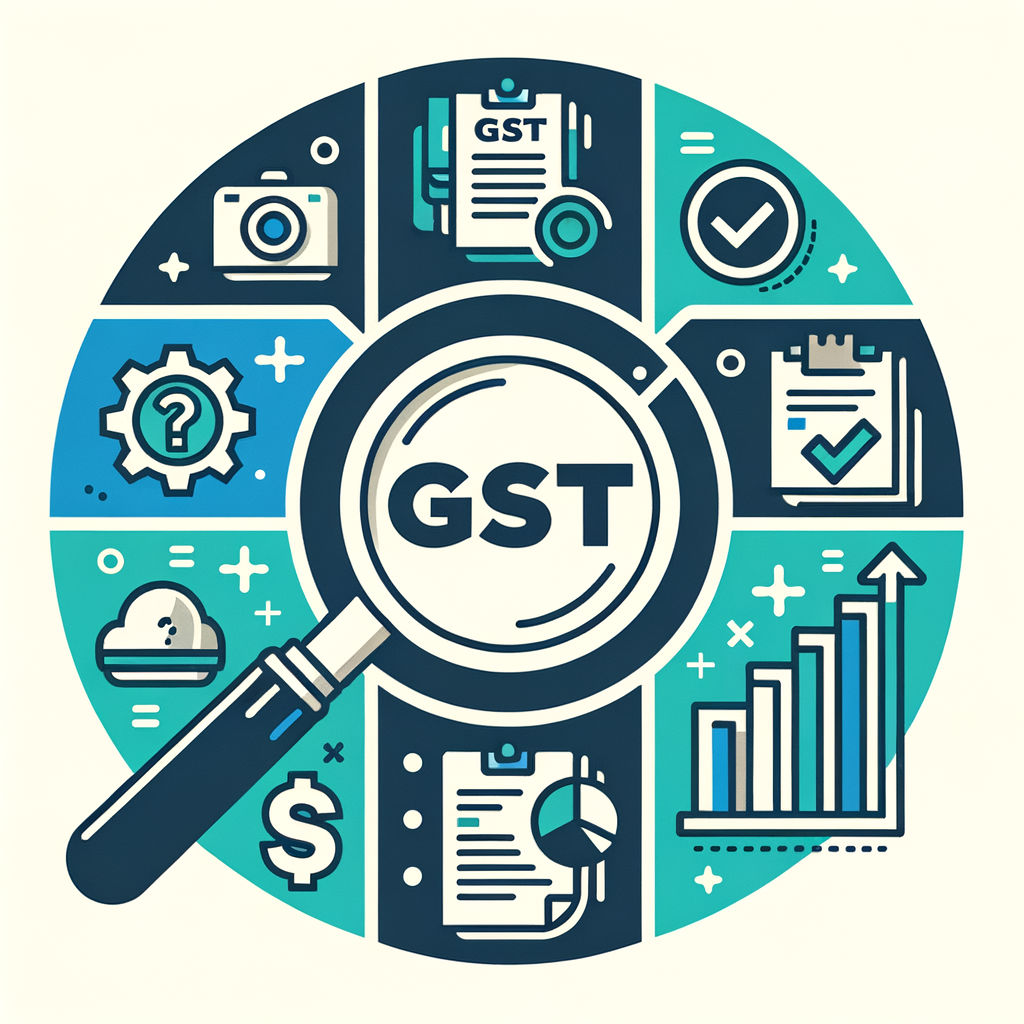Addressing Common Myths About Tax: A Guide to GST & Income Tax in India
Introduction: Why You Can’t Afford to Believe in Tax Myths
Taxes in India can feel like a complex maze, and widespread misinformation makes it even harder to navigate. From casual advice from a friend to outdated articles online, it’s easy to fall for one of the many common myths about tax. Relying on this kind of hearsay or old information is a risky strategy for both seasoned business owners and salaried professionals. It can lead to incorrect filings, missed deadlines, unexpected penalties, significant financial loss, and a great deal of unnecessary stress. This blog post will act as your definitive guide to debunking these persistent myths. We will clarify some of the most confusing concepts related to both the Goods and Services Tax (GST) for businesses and Income Tax for individuals, ensuring you have accurate information to build your financial strategy on. Let’s separate fact from fiction and empower you to manage your taxes with confidence.
Debunking 4 Common GST Myths for Small Business Owners
For small business owners, GST compliance is a non-negotiable part of operations. It directly impacts your cash flow, pricing, and legal standing. However, several myths and misconceptions can cause significant confusion and lead to costly errors. Let’s clear the air and look at the reality behind these common GST fallacies.
Myth 1: “GST registration is mandatory for every single business.”
The Reality: This is one of the most widespread myths. GST registration is not universally mandatory; it is tied to your annual aggregate turnover. The government has set specific thresholds to protect small businesses from immediate compliance burdens.
- For businesses exclusively supplying goods, mandatory registration is required if your annual turnover exceeds ₹40 lakhs.
- For businesses exclusively supplying services, the threshold is lower, at ₹20 lakhs.
- For businesses in Special Category States (like those in the North-East), the threshold is generally ₹20 lakhs for goods and ₹10 lakhs for services.
It’s crucial to note that registration becomes mandatory irrespective of turnover if you engage in inter-state supply, sell on e-commerce platforms, or fall under certain other specific categories.
Actionable Tip: Regularly monitor your annual aggregate turnover to determine if you have crossed the threshold. You can also opt for voluntary registration even if your turnover is below the limit. This allows you to claim Input Tax Credit (ITC) and issue tax invoices, which can make your business more attractive to larger corporate clients. For the most current thresholds, always refer to the official GST Portal.
Myth 2: “I have to file multiple, complicated returns every month.”
The Reality: The initial GST framework did involve multiple monthly returns, which was a challenge for small businesses. However, the system has evolved significantly to simplify compliance. The government introduced the Quarterly Return Monthly Payment (QRMP) scheme specifically to ease this burden.
Under the QRMP scheme, small taxpayers with an aggregate annual turnover of up to ₹5 crores can file their main returns (GSTR-1 and GSTR-3B) on a quarterly basis. While they still need to pay their tax liability monthly through a simple challan, the detailed filing process is only required once every three months. This drastically reduces the time and effort spent on compliance.
Actionable Tip: If your annual turnover is below ₹5 crores, assess your eligibility for the QRMP scheme. It can be a game-changer for managing your compliance workload, allowing you to focus more on your core business activities instead of monthly paperwork.
Myth 3: “Every product and service now has a high GST rate of 18% or 28%.”
The Reality: This is a major exaggeration. India’s GST regime is built on a multi-tiered tax structure designed to make essential items affordable while taxing luxury goods at a higher rate. The notion that everything falls into the 18% or 28% bracket is incorrect. The rates are divided into several slabs:
| GST Rate | Examples of Goods and Services |
|---|---|
| 0% | Unpackaged food grains, fresh milk, salt, healthcare services |
| 5% | Sugar, tea, coffee, edible oils, domestic LPG |
| 12% | Butter, cheese, processed foods, mobile phones |
| 18% | Soaps, toothpaste, capital goods, most industrial services |
| 28% | Luxury cars, air conditioners, cement, caffeinated drinks |
Actionable Tip: As a business owner, it is vital to correctly classify your goods and services using the HSN (Harmonized System of Nomenclature) for goods or SAC (Services Accounting Code) for services. Applying the wrong GST rate can lead to incorrect invoicing, tax demands, and penalties during an audit.
Myth 4: “Claiming Input Tax Credit (ITC) is impossible for small businesses.”
The Reality: Input Tax Credit (ITC) is a cornerstone of the GST system and is available to all registered businesses, regardless of size. Simply put, ITC allows you to reduce the tax you paid on your inputs (purchases) from the tax you need to pay on your output (sales). To claim ITC, you must meet a few key conditions:
- You must be in possession of a valid tax invoice or debit note from your supplier.
- You must have received the goods or services.
- The supplier must have paid the tax they collected from you to the government.
- The supplier must have filed their GST returns (GSTR-1).
The details of your supplier’s filings are reflected in your GSTR-2A and GSTR-2B forms, which you must reconcile with your purchase records. While this requires diligence, it is far from impossible.
Actionable Tip: Always partner with compliant suppliers who issue proper invoices and file their returns on time. Delays or non-compliance from your supplier can directly block your ITC. Using a professional service like TaxRobo’s accounting services can automate this reconciliation process, ensuring you never miss out on eligible credit and maintain perfect compliance.
Uncovering 4 Major Income Tax Myths for Salaried Individuals
Now, let’s switch gears and focus on addressing income tax misconceptions. The world of personal finance is filled with advice, but not all of it is accurate. Here are some of the most persistent tax myths Indian salaried professionals believe, and the truth you need to know.
Myth 1: “My employer deducted TDS, so I don’t need to file an ITR.”
The Reality: This is arguably one of the most dangerous income tax myths for salaried individuals. Tax Deducted at Source (TDS) is merely an advance tax collected by your employer on behalf of the government based on your salary and declared investments. Filing an Income Tax Return (ITR) is your legal obligation to the government, where you provide a comprehensive summary of all your income for the year and calculate your final tax liability.
Filing an ITR is mandatory if your gross total income exceeds the basic exemption limit. Furthermore, filing an ITR has several benefits:
- Claiming a Refund: If your employer deducted more TDS than your actual tax liability, filing an ITR is the only way to claim a refund.
- Proof of Income: Your ITR is a crucial legal document required for loan applications, visa processing, and high-value insurance policies.
- Carrying Forward Losses: If you have incurred losses from stocks or property, you can only carry them forward to set off against future gains if you file your ITR on time.
Actionable Tip: Treat TDS and ITR filing as two separate, mandatory steps. Always file your ITR before the due date, even if all your tax has been deducted. It is your official financial record and a mark of being a responsible citizen.
Myth 2: “I can declare income from freelancing or investments in my next year’s return.”
The Reality: This is another critical misconception from the myths of income tax in India. The income tax system works on a yearly cycle. You must declare all income earned during a specific Financial Year (April 1 to March 31) in the corresponding Assessment Year (the following year).
This includes every single source of income, not just your salary. Common additional income sources that must be reported are:
- Interest from savings accounts and fixed deposits.
- Income from freelance work or a side business.
- Capital gains from selling stocks, mutual funds, or property.
- Rental income.
- Winnings from lotteries or game shows.
Failing to declare these can be considered tax evasion and may lead to scrutiny, penalties, and interest charges from the tax department.
Actionable Tip: Throughout the financial year, maintain a clear record of all your income sources beyond your salary. Keep bank statements, Form 16A (for TDS on non-salary income), and capital gains statements organized. This will ensure your ITR filing is accurate and comprehensive.
Myth 3: “All tax-saving investments fall under the ₹1.5 Lakh limit of Section 80C.”
The Reality: While Section 80C is the most popular tax-saving provision, limiting your planning to just this section means you are likely leaving significant tax savings on the table. The Income Tax Act offers a wide array of deductions beyond the ₹1.5 lakh limit of Section 80C. Some other powerful sections include:
- Section 80D: Deduction for health insurance premiums paid for yourself, your family, and your parents.
- Section 80E: Deduction on the interest paid on an education loan, with no upper limit.
- Section 80G: Deduction for donations made to specified charitable institutions.
- Section 80CCD(1B): An additional deduction of up to ₹50,000 for contributions to the National Pension System (NPS), over and above the 80C limit.
Actionable Tip: Explore all available tax-saving avenues. A well-rounded tax plan looks beyond just 80C. Consider consulting an expert from TaxRobo who can analyze your financial situation and create a holistic tax-saving strategy that maximizes your deductions legally.
Myth 4: “I don’t need proof for deductions like HRA if the amount is small.”
The Reality: The onus to prove any claimed deduction or exemption always lies with the taxpayer. The Income Tax Department can demand documentary evidence for any claim you make in your ITR, regardless of the amount. For House Rent Allowance (HRA), it is mandatory to have a rental agreement and rent receipts, especially if the annual rent exceeds ₹1 lakh, in which case you also need the landlord’s PAN.
Relying on the hope that you won’t be asked for proof is a poor strategy. If you cannot produce the necessary documents during an assessment or inquiry, the deduction will be disallowed, and you will be liable to pay the tax along with interest and potentially a penalty.
Actionable Tip: Maintain a meticulous file—digital or physical—of all your financial documents for the year. This includes rent receipts, investment proofs (like ELSS statements or PPF passbooks), health insurance premium receipts, and donation certificates. Keep these documents safe for at least 7-8 years. For official information, you can always visit the Income Tax Department e-filing portal.
Conclusion: Stay Informed, Stay Compliant
Understanding the facts behind these common myths about tax is the first critical step toward smart financial management and stress-free compliance. Whether you are running a business or managing your personal salary, being well-informed protects you from financial penalties and empowers you to make better decisions. Tax laws are dynamic and can be complex, which is why relying on professional guidance is invaluable for ensuring accuracy and peace of mind.
Don’t let tax myths dictate your financial decisions. Whether you need help with GST filing, ITR preparation, or strategic tax planning, TaxRobo’s team of experts is here to provide accurate and reliable support. Contact us today for a consultation!
Frequently Asked Questions (FAQs)
1. Is GST registration necessary if I only sell services online?
Answer: Yes, in most cases. If you are providing services inter-state (to a customer in another state), GST registration is mandatory regardless of your turnover. The turnover threshold exemptions do not apply to inter-state supplies of services.
2. What is the penalty for not filing an ITR on time?
Answer: There is a late filing fee under Section 234F, which can be up to ₹5,000 if your income is above ₹5 lakh. Additionally, you may have to pay interest under Section 234A on any outstanding tax liability, and you will not be able to carry forward certain types of losses to future years.
3. Can I revise my ITR if I make a mistake?
Answer: Yes, you can file a revised return to correct any error, omission, or wrong statement made in your original ITR. You can file a revised return before the end of the assessment year or before the completion of the assessment, whichever is earlier. It’s always better to correct it yourself than to wait for a notice from the tax department.
4. How can TaxRobo help me avoid these tax myths and errors?
Answer: TaxRobo provides end-to-end tax and compliance solutions. Our experts stay constantly updated with the latest laws and regulations to ensure your GST and Income Tax returns are filed accurately, on time, and in a way that maximizes your legal savings. We help you navigate the complexities, maintain perfect compliance, and avoid the pitfalls of common tax misinformation.



